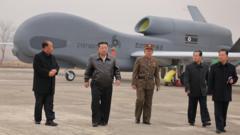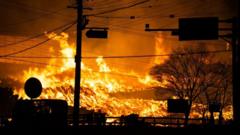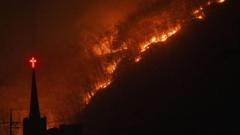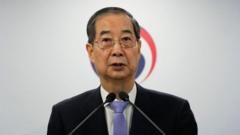The nation's largest wildfires have led to tragic loss of life, extensive damage, and raised concerns about climate change and preparedness for natural disasters.
Devastating Wildfires Rage Across South Korea: A Crisis Unfolds
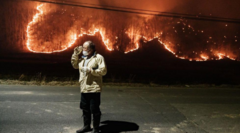
Devastating Wildfires Rage Across South Korea: A Crisis Unfolds
Unprecedented wildfires fueled by climate conditions and vulnerable pine forests have wreaked havoc in South Korea.
As South Korea grapples with its deadliest wildfires to date, experts attribute the disaster to a lethal mix of environmental factors—dry terrain, strong winds, and a powerful concentration of resinous pine trees. The flames have consumed approximately 35,810 hectares (88,500 acres), an area approaching half the size of New York City, with a reported death toll reaching 27 and tens of thousands forced to flee their homes.
Authorities indicate that human activity sparked the initial blazes, but it is the combination of exceptionally dry weather and gusty winds that has accelerated their spread. Forest disaster expert Lee Byung-doo highlights the role of pine trees in the region, stating, "the resin these trees contain acts like oil, boosting fire intensity." The pine forests, particularly prevalent in North Gyeongsang province, have contributed significantly to the flames' rapid and widespread advance.
The fire situation has proven especially desperate in Andong, a city renowned for its serene pine forests which, in this case, have turned perilous. Lee explains that unique traits of pine trees make them prone to crown fires, where flames leap from tree to tree via the dense canopy overhead. The past weeks of unseasonably warm temperatures, exceeding 20 degrees Celsius (68 degrees Fahrenheit), have exacerbated the situation. Climate Central's analysis reveals that global warming has made such extremes five times more probable, leaving the landscape ripe for wildfire.
Despite South Korea's advancements in forest cover, the accumulation of fallen leaves and pine needles has heightened wildfire risks, as noted by disaster prevention expert Baek Min-ho. The country’s disaster chief, Lee Han-kyung, framed the blazes as stark reminders of the urgent climate crisis facing the nation.
Tragically, the high casualty rate includes many elderly, with about 80% of the deceased in their 60s and 70s. The region, being one of South Korea's oldest provinces, has also faced challenges in evacuating vulnerable populations. Illustrating the difficulties, reports emerged of an elderly care vehicle engulfed in flames, leading to three fatalities. Acting President Han Duck-soo expressed concern over the elderly death toll, mandating effective relief measures.
Losses extend beyond human lives, as numerous historical relics have been lost, including treasures from temples dating back to the Silla dynasty. Local resident accounts convey shock at the speed of the fires, emphasizing a lack of preparedness and the need for improved evacuation strategies to better protect vulnerable groups. The impact of climate change and inadequate disaster responses has ignited urgent discussions about future prevention and preparedness in the face of increasingly harsh environmental conditions.
Authorities indicate that human activity sparked the initial blazes, but it is the combination of exceptionally dry weather and gusty winds that has accelerated their spread. Forest disaster expert Lee Byung-doo highlights the role of pine trees in the region, stating, "the resin these trees contain acts like oil, boosting fire intensity." The pine forests, particularly prevalent in North Gyeongsang province, have contributed significantly to the flames' rapid and widespread advance.
The fire situation has proven especially desperate in Andong, a city renowned for its serene pine forests which, in this case, have turned perilous. Lee explains that unique traits of pine trees make them prone to crown fires, where flames leap from tree to tree via the dense canopy overhead. The past weeks of unseasonably warm temperatures, exceeding 20 degrees Celsius (68 degrees Fahrenheit), have exacerbated the situation. Climate Central's analysis reveals that global warming has made such extremes five times more probable, leaving the landscape ripe for wildfire.
Despite South Korea's advancements in forest cover, the accumulation of fallen leaves and pine needles has heightened wildfire risks, as noted by disaster prevention expert Baek Min-ho. The country’s disaster chief, Lee Han-kyung, framed the blazes as stark reminders of the urgent climate crisis facing the nation.
Tragically, the high casualty rate includes many elderly, with about 80% of the deceased in their 60s and 70s. The region, being one of South Korea's oldest provinces, has also faced challenges in evacuating vulnerable populations. Illustrating the difficulties, reports emerged of an elderly care vehicle engulfed in flames, leading to three fatalities. Acting President Han Duck-soo expressed concern over the elderly death toll, mandating effective relief measures.
Losses extend beyond human lives, as numerous historical relics have been lost, including treasures from temples dating back to the Silla dynasty. Local resident accounts convey shock at the speed of the fires, emphasizing a lack of preparedness and the need for improved evacuation strategies to better protect vulnerable groups. The impact of climate change and inadequate disaster responses has ignited urgent discussions about future prevention and preparedness in the face of increasingly harsh environmental conditions.






